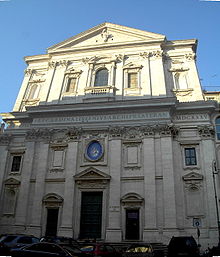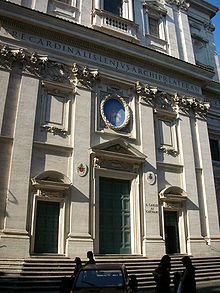San Carlo ai Catinari
San Carlo ai Catinari is a church in Rome from the 17th century and under the patronage of Santi Biagio e Carlo ai Catinari ( Latin Sancti Blasii et Caroli ad Catinarios ) a titular diaconia of the Roman Catholic Church . It contains u. a. Frescoes by Domenichino and a painting by Pietro da Cortona .
location
The church is located in the VIII. Roman Rione Sant'Eustachio at the Piazza Benedetto Cairoli about 200 m southwest of the Largo di Torre Argentina .
Naming and building history
The church got its nickname from the surrounding workshops, in which u. a. Jugs and sinks ( Italian catini ) were made.
Construction work began in 1612 based on a design by Rosato Rosati . The facade was completed in 1635 by Giovanni Battista Soria . The apse was erected three years later and the construction work was completed in 1650.
Basic structure
A Greek cross forms the floor plan of the church , the nave opens into side chapels . Above the transept one rises dome .
Exterior
The facade is a wide baroque facade . It is divided into five vertical axes, the three middle of which in the form of a Risalites are made protruding. The delimiting pilasters have Corinthian capitals. The facade is divided horizontally into two floors by a strong cornice . Window shades and niches further divide the facade.
Interior
The interior of the church is dominated by the mighty pillars over which the dome rises. Following the style of the time, the interior is magnificently designed in high baroque forms. The barrel vault above the nave is geometrically coffered , side chapels open towards the nave. The pilasters on the side walls have Corinthian capitals . Between the windows there are frescoes by Francesco Coghetti .
dome
The dome drum is broken through by twelve windows. There are four frescoes by Domenichino on the dome consoles , depicting the four cardinal virtues ( wisdom , valor , prudence and justice ).
Interior
Apse and altar
The apse was frescoed by Giovanni Lanfranco with The Ascension of St. Charles Borromeo . It was finished in 1647 and was his last work. The high altar was designed by Martino Longi d. J. created. The altarpiece depicts St. Charles Borromeo carrying a nail from the cross of Christ and was made by Pietro da Cortona .
sacristy
In the sacristy there is a fresco by Guido Reni . This depicts St. Charles Borromeo praying .
More works of art
The altarpiece on the left cross arm depicts The Death of St. Anna and was painted by Andrea Sacchi . To the right of the entrance is the Annunciation by Giovanni Lanfranco on the altar there . In the church there is also a triptych with the representation of the Mother of God between John the Baptist and the Archangel Michael . The picture was created by Leonardo da Roma in 1453. What is remarkable about this is that in the midst of the early Renaissance this painting was still painted in late Gothic form.
aftermath
The building could be a model for the Ste. Ursule in the Sorbonne . This was started in 1635, the builder was Jacques Lemercier , who previously stayed in Rome and u. a. studied the buildings of Giacomo della Porta .
Cardinal priest
Between October 17, 1616 and 1627 it was a titular church. The following cardinals held the title:
- Ottavio Belmosto (Belmusti) (October 17, 1616 - November 16, 1618)
- Luigi Capponi (May 5, 1621 - May 2, 1622, then cardinal priest of San Pietro in Vincoli )
- Giovanni Delfino (23 August 1622 - 25 November 1622)
Cardinal deacons
Pope John XXIII established the title diakonia on December 2, 1959. Since then, the following cardinals have held its title:
- Arcadio María Larraona Saralegui , CMF (December 14, 1959 to April 28, 1969, then cardinal priest of Sacro Cuore di Maria )
- Luigi Raimondi (March 5, 1973 to June 24, 1975)
- Giuseppe Maria Sensi (May 24, 1976 to June 22, 1987, then cardinal priest of Regina Apostolorum )
- Angelo Felici (June 28, 1988 to June 17, 2007)
- Leonardo Sandri (since November 24, 2007; since June 28, 2018 Cardinal Bishop pro hac vice )
literature
- Johann M. Wiesel: Rome. An art and travel guide. 7th edition Kohlhammer, Stuttgart 19680, ISBN 3-17-005633-6 .
- Anton Henze: Art Guide Rome. Art monuments and museums (= Reclams Art Guide; Vol. 5). 5th edition Reclam, Stuttgart 1994, ISBN 3-15-008679-5 (former title: Rom und Latium ).
- Rolf Toman (ed.), Achim Bednorz (photos): The art of the baroque. Architecture, sculpture, painting. Könemann, Cologne 1997, ISBN 3-89508-991-5 .
- Marco Bussagli (Ed.): Rome. Art & Architecture ( Roma, l'arte nei secoli ). New edition Edition Ullmann, Königswinter 2007, ISBN 978-3-8331-3588-0 .
Web links
- Vedute engraving by Giuseppe Vasi (Italian)
Individual evidence
- ↑ Marco Bussagli (ed.): Rome. Art & Architecture , p. 381.
- ^ Rolf Toman (Red.): The art of the baroque. Architecture, sculpture, painting , p. 128.
- ^ David M. Cheney: San Carlo ai Catinari (Cardinal Titular Church) (Catholic-Hierarchy). Retrieved April 15, 2017 .
Coordinates: 41 ° 53 ′ 39.1 ″ N , 12 ° 28 ′ 30.9 ″ E




